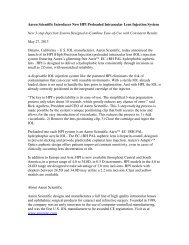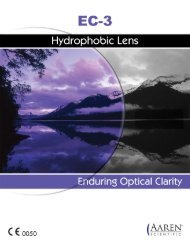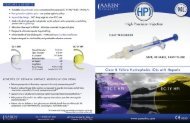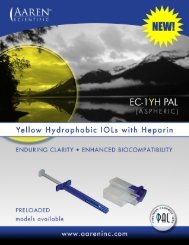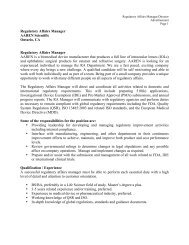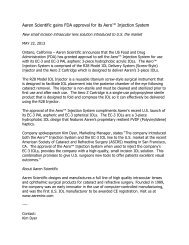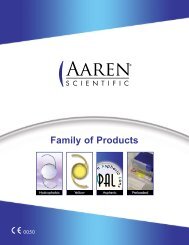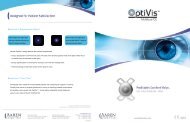Hydrophobic Acrylic IOLs: A Primer - Aaren Scientific
Hydrophobic Acrylic IOLs: A Primer - Aaren Scientific
Hydrophobic Acrylic IOLs: A Primer - Aaren Scientific
You also want an ePaper? Increase the reach of your titles
YUMPU automatically turns print PDFs into web optimized ePapers that Google loves.
COVER STORYcontact inhibition of migrating LECs at the capsular bendcreated by the edge, 8 the higher pressures exerted by<strong>IOLs</strong> with a square-edged optic profile on the posteriorcapsule, 9 or combinations of these factors.Current hydrophobic acrylic <strong>IOLs</strong> generally have asquare optic edge. However, not all square edges are thesame. In an experimental study including 19 hydrophobicacrylic lenses, the area above the posterior-lateral edge ofeach IOL was measured to determine the deviation froma perfect square. 10 Variation was found not only amongthe IOL designs but also among different powers of thesame IOL. This type of evaluation can help manufacturersoptimize their <strong>IOLs</strong>’ optic edges. For example, HoyaCorp. (Tokyo) modified the edge profile of several AF-1models after results of a single-surgeon prospective felloweyecomparison showed that the PCO rate was significantlyhigher with the AF-1 YA-60BB IOL than with theAcrySof SN60AT. 11 The study was based on results in 36patients who were followed for 24 months. The result isnot surprising, considering the differences in edge designbetween these lenses in the amount of area deviatingfrom a perfect square (AF-1, 329.7 µm 2 ; SN60AT [20.00D], 97.2 µm 2 ). 10 Hoya made several manufacturingchanges, including variations in polishing process, anddifferent prototypes were sent for evaluation. 12 The areadeviating from a perfect square in the current Hoya AF-1family now measures 39.1 µm 2 . Such quantification of thearea deviating from a perfect square—and thereforeassessment of the sharpness of the posterior opticedge—is not available for many new models ofhydrophobic acrylic lenses.Another design trend observed in hydrophobic acrylicIOL manufacturing is the availability of new <strong>IOLs</strong> in a onepieceplatform. Most prospective, randomized studieshave shown no statistically significant differences betweenone- and three-piece hydrophobic acrylic <strong>IOLs</strong> in terms ofPCO rate; 13 however, it has been shown that, wheneverPCO occurs with one-piece designs, it has the tendencyto start at the level of the optic-haptic junction. 7Several manufacturers have modified the optic-hapticjunctions of their <strong>IOLs</strong> to obtain a continuous 360ºsquare edge. In one study, patients were implanted with aTAKE-HOME MESSAGE• Lens materials must be both uveal and capsularbiocompatible.• Most hydrophobic acrylic <strong>IOLs</strong> have a square edge;however, the deviation from a perfect square can varydepending on IOL design and IOL power.• The tendency for glistenings varies depending on the IOLmaterial, manufacturing technique, and packaging process.one-piece hydrophobic acrylic IOL with an interruptedoptic edge (AcrySof) in one eye and a newer one-piecehydrophobic acrylic IOL with a continuous optic edge(Tecnis 1-Piece; Abbott Medical Optics Inc.) in theother. 14 Two years after surgery, the extent and density ofPCO were significantly greater in eyes with the AcrySofIOL that those with the Tecnis IOL.BLUE-LIGHT FILTERING CHROMOPHORESSome hydrophobic acrylic lenses incorporate blue-lightfiltering chromophores, as it has been suggested thatblue-light–filtering <strong>IOLs</strong> protect lipofuscin-containingretinal pigment epithelial cells from blue-light damage. 15There is indirect evidence suggesting that blue-light filtersmay result in a reduced risk of development or progressionof macular degeneration, but the value of these yellowchromophore–containinglenses is not fully understood.Potential side effects of constantly filtering blue light mayinclude negative impacts on color vision, night vision, andsleep and circadian rhythms. 16One photochromic lens (Matrix Aurium; Medennium,Irvine, California) turns yellow when exposed to ultraviolet(UV) light because the blue light is absorbed. The lensbehaves as a standard UV-absorbing IOL in an indoorenvironment; the optic remains colorless, and there is nofiltering of blue light. This innovative concept theoreticallyeliminates the potential side effects of yellow <strong>IOLs</strong> andprovides patients with the potential for improved nightvision after cataract surgery, additional protection of themacula against blue light in daylight conditions, andimproved contrast sensitivity (as demonstrated in clinicalstudies with yellow lenses). 17In a rabbit study conducted in our laboratory, thelong-term biocompatibility and photochromic stabilityof the photochromic IOL were evaluated under extendedUV light exposure (simulating 20 years of exposure). 17The photochromic change was found to be reversible (ie,the optic returned to its colorless state after discontinuationof UV light projection) and reproducible (ie, thephotochromic change was observed at different timepoints in the clinical follow-up). Additionally, the photochromicproperty of the optic material remained stableand was present and unchanged 12 months after implantation.The rabbit eyes exhibited clinical and histopathologicchanges that are normally expected in this model,and there was no difference between study and controleyes in terms of biocompatibility.GLISTENINGSGlistenings are fluid-filled microvacuoles that formwithin an IOL optic when the lens is in an aqueous environment.3 They can be observed with any type of IOL,40 CATARACT & REFRACTIVE SURGERY TODAY EUROPE MARCH 2011



